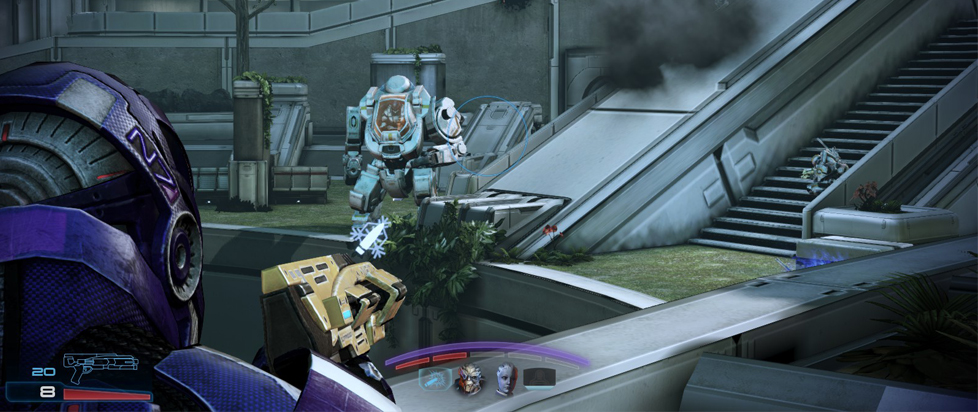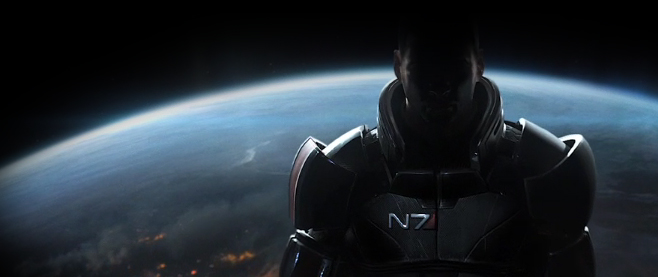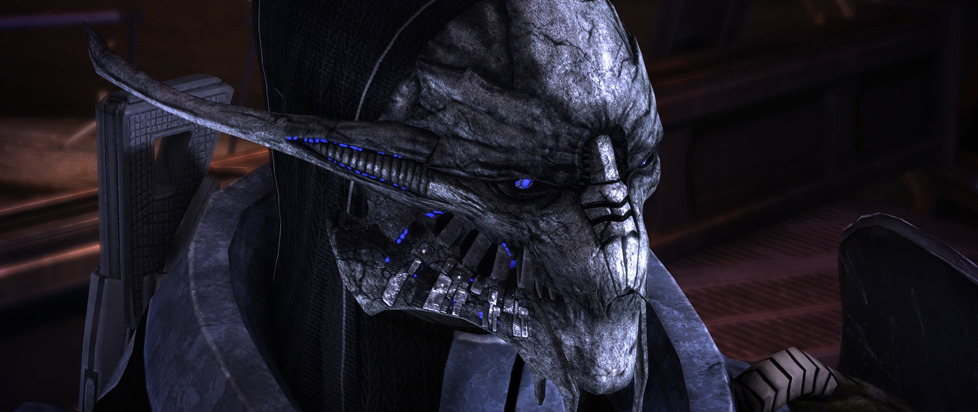
The Most Difficult Fight in Mass Effect 3
Relatively early in Mass Effect 3, you’re given a side quest to go to Grissom Academy and rescue some Human biotic students from Cerberus. Nothing about the mission seems special (though it’s associated with Kahlee Sanders, a character from the series novels making her first game appearance) and structurally Grissom functions as the Jack mission in the process of reuniting with all of the Mass Effect 2 squadmates. What makes Grissom special is that it includes one of the best, hardest (and sometimes hated) fights in the entire series: the Atrium.
There are three different tensions involved in Mass Effect level design. At the macro level, combat tends to fall into two basic categories, either with Shepard and your squad attacking and defending enemies or Shepard being attacked. Most fights put Shepard on the attack, and thematically it makes sense since the games are designed to give the player and their avatar as much agency as possible. Shepard and the player are pushing forward through space and story, with enemies trying to stop both in each new room. It’s thematically consonant.
That’s the case with the Atrium, where not only is Shepard continuing to navigate Grissom Academy, but has also just encountered the emotional high point of the side quest, the meeting with Jack and the biotic students. With extra resolve, a new goal and even a slight diversion to unlock the door (demonstrating the importance of what’s coming next, Shepard steps into the Atrium…and is immediately confronted by a missile-launching Atlas mech and a tough set of enemies. Everything about this battle says that it should be a tough assault, and it certainly is.
(Side note: technically there are two Atrium battles, but the first is so much more interesting and difficult that it’s what will be referred to throughout.)
Defensive battles, on the other hand, are relatively rare in Mass Effect, but are effectively used for variety throughout, with you moving on your heels instead of simply pushing forward. The Atrium battle impressively utilizes this in large part because it uses defensive-style variety while still gaining the thematic strength of being a offensive encounter.
Attacking missions fall too often into a rut of fight, kill, move forward, repeat. This tension is consistent in all cover-based shooters derived from Gears of War. In its purest state, the cover shooter involves row after row of cover. You hide behind it, pick off the enemies in from and hop up to the next piece. Gears creator Cliff Bleszinski, has likened it to a platformer, only traveling horizontally from cover to cover instead of jumping vertically.
The problem with that ideal form is that it makes the player boringly comfortable. The recharging shields of most games in cover shooters mean that hiding to recharge, picking off enemies and repeating as necessary is generally the best, safest strategy, unless (or until) the player is pushed out of that comfort zone. Gears of War does this with the powerful, seductively gruesome melee attacks, which Mass Effect copies to some extent (especially in ME3). Yet at its best, Mass Effect uses level design to encourage players to “pivot,” staying in roughly the same place, but shifting focus to an entirely new space and set of enemies.
Pivoting works because it allows the players to get the thrill of success in one direction only to immediately feel the challenge of having to face a new threat. There’s also a conceptual joy in seeing the same game spaces repurposed so quickly; what was the threatening area is now safe while a previously irrelevant zone is now the focus of the battle. This also lets long fights be divided into easily understood phases, allowing a strong sense of progress. Good pivoting places the player in exhilaratingly uncomfortable situations – and tough pivoting forces players to have to move, not just shift and aim.
The interior design of the Atrium battle itself is worth looking at. Immediately upon walking through the door leading into it, you’re put off guard. There is some broken cover directly in front of you, with tougher Cerberus units advancing on your position. More importantly, far behind them (and actually inaccessible to you) is an Atlas mech, launching rockets. It’s safe behind Shepard, and to the left is a wall. But to the right is a ramp curving up, and around, leading to, eventually, a 90 degree angle from the Atlas.
Cover-based shooters and Mass Effect rarely use curves. This is intentional. As level concepts go, it’s much easier to create a situation where cover exists in straight lines, and thus flanking calculations are far easier (see 2012’s XCOM: Enemy Unknown, a turn-based tactics game where any cover works at any angle up to being flanked at 90 degrees). Furthermore, level design is also simpler (the player has this cover to use and work towards against enemies, who have theirs opposing your position).
The Atrium’s curved ramp serves that purpose. The positioning of the Atlas mech becomes the center of the player focus, instead of a more typified north-south grid. Players will likely be drawn up the ramp, as it has both height and the ability to focus on the Atlas and every other Cerberus unit in the center of the Atrium. There are a few waves of reinforcements as the battle progresses, and ME3 drops them in parts of the level where the player isn’t. Thus unless the player climbs up the ramp quickly, the first batch will almost certainly appear at the top, and walk down, flanking Shepard facing the Atlas.
Moves partially up the ramp and you’re in the most trouble. Because of the curve, you can be flanked from both sides of the ramp if you continue to face the mech. There are little protrusions which can be used to gain cover facing directly up or down the ramp, but that leaves you exposed to fire from behind and below, particularly from the Atlas. Climbing all the way up the ramp doesn’t help either, since Cerberus troops can hop up the ramp at any point using their jetpacks.
Even if you do manage to succeed at carving out a temporarily defensive position, the enemy types force different reactions in the second half of the battle. The initial Cerberus waves are primarily their heavy infantry, Guardians and Centurions, But later reinforcement waves are mostly their Combat Engineers. On their own these enemies aren’t deadly, but are able to set up Turrets if given enough space. And Turrets are, especially at higher difficulty levels, among the most annoying enemies to fight, because they tear through player shields, don’t need to cool down or reload quickly, and force you into constant cover. But there isn’t enough cover in the Atrium – Turrets immediately force a new kind of panic.
Thus the Atrium fight immediately forces Shepard to pay attention from all sides. You need to be constantly reacting to whichever direction Cerberus is attacking from, while not allowing yourself to be flanked, which is inevitable. But you also need to push forward and continue getting kills to gain sufficient tactical advantage. It can be overwhelming. In Mass Effect, and in many cover-based shooters, this is a rare feeling. So when it clicks, it’s superb. But when it doesn’t, it’s probably because of the third, impossible tension: difficulty.
The Atrium fight is probably the most difficult battle in all of Mass Effect 3. I say “probably” because it depends on when you do it – ME3, like every other recent BioWare game, has an unbalanced difficulty in that it’s significantly tougher in the early stages of the game than the later stages. Since Grissom can be done at almost any point between 1/3 and 2/3s of the way through the game, the adaptive difficulty doesn’t always work. In other words, this is the battle people remember dying repeatedly on and even hating.
For me, the question of quality combat design comes down to this: do I feel like I can win if I do it right? Is it fair? At higher difficulty levels, the original Mass Effect is distinctly unfair. A single Krogan charge or Geth rocket can instantly kill Shepard and end the game. In Grissom Academy, the level design is such that, even while panicking, players can realize that there’s always a better spot, a better move, a better use of skills.
As long as that’s available, this is a well-designed, tough fight. But if your preparations are off – if you’re too low-level or pick the wrong weapons or squadmates for the shields and armor of the toughest enemies in the Atrium, it can be a massive pain and very unforgiving. Temperment is also important here. I like missions that challenge me to the point of needing to repeat them several times, but I know many people who don’t.
With that said, you can still see the design decisions of the Atrium fight at play in the Mass Effect 3 multiplayer, the most finely-honed form of combat in the series. Randomly spawning enemies in areas constantly force pivots, movement and panic. But the Atrium has two aspects that make it unique: the inaccessible Atlas and the ramp. These combine with Mass Effect 3’s story, enemies, randomization and combat to create one of the most memorable battles in the series – even if memorable doesn’t always mean loved.




